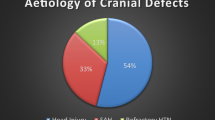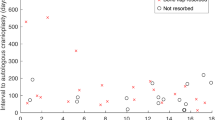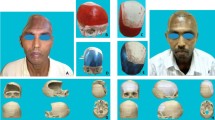Abstract
In recent times a steady rise in cranioplasty operations has been noted because of increasing utilisation of decompressive craniectomy for trauma as well as stroke patients. A variety of techniques have been utilised for cranioplasty, with their own benefits and limitations. Titanium cranioplasty is one of the well-established and widely used techniques, with most centres utilising computer-assisted reconstruction for manufacture of titanium plates. In this paper we present a novel method for making titanium cranioplasty plates using the craniectomy bone flap as a template and the results of our experience. To date we have performed 51 cranioplasties using this method. The surgical results have been comparable to those obtained using the computer-assisted model technique. The construction cost for titanium cranioplasty plates using this method has been £360 cheaper per plate compared with the computer-assisted method. In addition, the CT workload and radiation exposure have been reduced.









Similar content being viewed by others
References
Chen TM, Tsai JC, Burnouf T (2008) Cranioplasty using osteoconductive scaffold and platelet glue. J Trauma 65(6):1321–1327. doi:10.1097/TA.0b013e3181574edf
European Union (2004) EU tissues and cells directive (2004/23/EU). European Union
Fathi AR, Marbacher S, Lukes A (2008) Cost-effective patient-specific intraoperative molded cranioplasty. J Craniofac Surg 19(3):777–781. doi:10.1097/SCS.0b013e31816b1b2a
Greene AK, Warren SM, McCarthy JG (2008) Onlay frontal cranioplasty using wire reinforced methyl methacrylate. J Craniomaxillofac Surg 36(3):138–142. doi:10.1016/j.jcms.2007.05.008
Grossman N, Shemesh-Jan HS, Merkin V, Gideon M, Cohen A (2007) Deep-freeze preservation of cranial bones for future cranioplasty: nine years of experience in Soroka University Medical Center. Cell Tissue Bank 8(3):243–246. doi:10.1007/s10561-006-9032-x
Hieu LC, Vander Sloten J, Bohez E, Phien HN, Vatcharaporn E, An PV et al (2004) A cheap technical solution for cranioplasty treatments. Technol Health Care 12(3):281–292
Joffe JM, Nicoll SR, Richards R, Linney AD, Harris M (1999) Validation of computer-assisted manufacture of titanium plates for cranioplasty. Int J Oral Maxillofac Surg 28(4):309–313. doi:10.1016/S0901-5027(99)80165-9
Kriegel RJ, Schaller C, Clusmann H (2007) Cranioplasty for large skull defects with PMMA (Polymethylmethacrylate) or Tutoplast processed autogenic bone grafts. Zentralbl Neurochir 68(4):182–189. doi:10.1055/s-2007-985857
Li G, Wen L, Zhan RY, Shen F, Yang XF, Fu WM (2008) Cranioplasty for patients developing large cranial defects combined with post-traumatic hydrocephalus after head trauma. Brain Inj 22(4):333–337. doi:10.1080/02699050801958353
Maravelakis E, David K, Antoniadis A, Bilalis A, Manios N, Papaharilaou Y (2008) Reverse engineering techniques for cranioplasty: a case study. J Med Eng Technol 32(2):115–121. doi:10.1080/03091900600700749
Marbacher S, Andres RH, Fathi AR, Fandino J (2008) Primary reconstruction of open depressed skull fractures with titanium mesh. J Craniofac Surg 19(2):490–495. doi:10.1097/SCS.0b013e3181534ae8
Marchac D, Greensmith A (2008) Long-term experience with methylmethacrylate cranioplasty in craniofacial surgery. J Plast Reconstr Aesthet Surg 61(7):744–752. doi:10.1016/j.bjps.2007.10.055
Matsumo A, Tanaka H, Iwamuro H, Takanashi S, Miyawaki S, Nakashima M et al (2006) Analyses of the factors influencing bone graft injection after delayed cranioplasty. Acta Neurochir (Wien) 148(5):535–540. doi:10.1007/s00701-006-0740-6
Peek BS, Friedman A, Levin LS A, Marcus JR (2008) Management of postneurosurgical bone flap loss caused by infection. Plast Reconstr Surg 122(6):195e–208e. doi:10.1097/PRS.0b013e3181858eee
Rotaru H, Baciut M, Stan H, Bran S, Chezan H, Iosif A et al (2006) Silicone rubber mould cast polyethylmethacrylate-hydroxyapatite plate used for repairing a large skull defect. J Craniomaxillofac Surg 34(4):242–246. doi:10.1016/j.jcms.2006.01.005
Sanus GZ, Tanriverdi T, Ulu MO, Kafadar AM, Tanriover N, Ozlen F (2008) Use of Cortoss as an alternative material in calvarial defects: the first clinical results in cranioplasty. J Craniofac Surg 19(1):88–95
Solaro P, Pierangeli E, Pizzoni C, Boffi P, Scalese G (2008) From computerized tomography data processing to rapid manufacturing of custom-made prostheses for cranioplasty. Case report. J Neurosurg Sci 52(4):113–116
Staffa G, Nataloni A, Compagnone C, Servadei F (2007) Custom made cranioplasty prostheses in porous hydroxy-apatite using 3D design techniques: 7 years experience in 25 patients. Acta Neurochir (Wien) 149(2):161–170. doi:10.1007/s00701-006-1078-9
Tadros M, Costantino PD (2008) Advances in cranioplasty: a simplified algorithm to guide cranial reconstruction of acquired defects. Facial Plast Surg 24(1):135–145. doi:10.1055/s-2008-1037455
Takumi I, Akimoto M (2008) Catcher’s mask cranioplasty for extensive cranial defects in children with an open head trauma: a novel application of partial cranioplasty. Childs Nerv Syst 24(8):927–932. doi:10.1007/s00381-007-0574-4
Tubbs RS, Loukas M, Shoja MM, Salter F, Salter EG, Oakes WJ (2008) Use of autologous scapula for cranioplasty: cadaveric feasibility study. Childs Nerv Syst 24(8):955–959. doi:10.1007/s00381-008-0592-x
Yuen YHW, Chen JM (2008) Reconstructive options for skull defects following translabyrinthine surgery for vestibular schwannomas. Curr Opin Otolaryngol Head Neck Surg 16(4):318–324. doi:10.1097/MOO.0b013e32830139b8
Author information
Authors and Affiliations
Corresponding author
Rights and permissions
About this article
Cite this article
Bhargava, D., Bartlett, P., Russell, J. et al. Construction of titanium cranioplasty plate using craniectomy bone flap as template. Acta Neurochir 152, 173–176 (2010). https://doi.org/10.1007/s00701-009-0394-2
Received:
Accepted:
Published:
Issue Date:
DOI: https://doi.org/10.1007/s00701-009-0394-2




